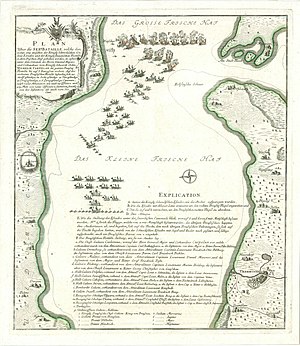Battle of Frisches Haff
| Slaget vid Das Frisches Haff | |||||||
|---|---|---|---|---|---|---|---|
| Part of the Pomeranian War (Seven Years' War) | |||||||
 Plan of the battle |
|||||||
|
|||||||
| Belligerents | |||||||
|
|
|
||||||
| Commanders and leaders | |||||||
| Carl Rutensparre Wilhelm von Carpelan |
Captain von Köller | ||||||
| Strength | |||||||
| 28 ships 2,250 men |
13 ships 700 men |
||||||
| Casualties and losses | |||||||
| 13 dead 14 wounded |
9 ships captured or sunk 70–80 dead 600 captured |
||||||
The battle of Frisches Haff or battle of Neuwarp was a naval battle between Sweden and Prussia that took place 10 September 1759 as part of the ongoing Seven Years' War. The battle took place in the Oder Lagoon (German: Oderhaff) between Neuwarp and Usedom, and is named after an ambiguous earlier name for the Lagoon, Frisches Haff, which later exclusively denoted the Vistula Lagoon.
Swedish naval forces consisting of 28 vessels and 2,250 men under Captain Lieutenant Carl Rutensparre and Wilhelm von Carpelan destroyed a Prussian force of 13 vessels and 700 men under captain von Köller.
The consequence of the battle was that the small fleet Prussia had at its disposal ceased to exist. The loss of naval supremacy meant also that the Prussian positions at Usedom and Wollin became untenable and were occupied by Swedish troops.
At the outbreak of the conflict, Sweden was led by a government dominated by the pro-French Caps party, which felt that this war (mainly aimed against Prussia) was the chance for Sweden to recapture territories lost to Prussia in the past in Pomerania and restore the mouth of the Oder to Swedish control. The chancellor and head of the Caps party, baron Anders Johan von Höpken, sent an army of 14,500 men to Stralsund, capital of Swedish Pomerania, under field-marshal Ungern-Sternberg, with his main mission being the capture of Stettin (today in Poland), which controls the mouths of the Oder.
The Swedes launched a first offensive but were beaten back in Stralsund by the Prussian army under marshal Lehwaldt. Ungern-Sternberg was replaced by count von Rosen, who took no risks and left himself blockaded in Stralsund. However, a Russian offensive in west Prussia forced Lehwaldt to leave Swedish Pomerania on 27 June 1758. Sweden sent reinforcements and a new commander-in-chief, count Hamilton, who profited from Prussian difficulties by going back on the offensive. Although Prussian troops in the area had been heavily denuded to face the Russian threat, they put up a tenacious resistance to the Swedes and battles and skirmishes came one after the other without either of the belligerents able to gain a decisive advantage over the other. The conflict took a naval turn when the Prussians built a fleet at Stettin, by the more or less fortunate transformation of fishing or transport boats into warships, to defy a Swedish squadron supporting their land offensive. Informed of these preparations, the Swedes decided to destroy this fleet.
...
Wikipedia
